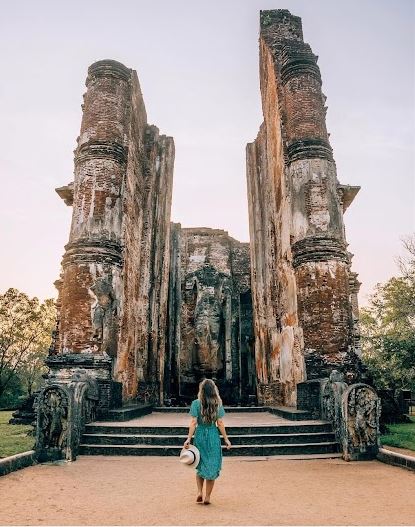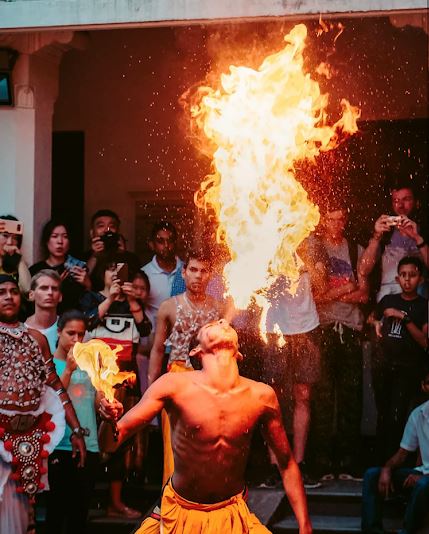Culture of Sri Lanka



Culture of Sri Lanka is a rich tapestry woven from its ancient history, diverse ethnic groups, religious traditions, and vibrant arts. The island’s strategic location in the Indian Ocean has also contributed to its cultural diversity, with influences from India, Southeast Asia, Europe, and the Middle East.
Day Tours to Main Cultural Sites
There are many Cultural Heritage sites to visit. Most famous places are Anuradhapura, Polonnaruwa, Kandy and Sigiriya.
Religious Diversity
- Buddhism: The dominant religion in Sri Lanka, followed by about 70% of the population. Introduced in the 3rd century BCE by Mahinda Thera, Buddhism plays a central role in the cultural and spiritual life of the Sinhalese majority. The country is dotted with ancient stupas, temples, and monasteries, and the teachings of Buddha influence many aspects of daily life.
- Hinduism: Practiced mainly by the Tamil population, Hinduism has a significant presence, especially in the Northern and Eastern provinces. Hindu temples, festivals like Deepavali, and rituals are integral to Tamil culture in Sri Lanka.
- Islam: The Muslim community, primarily of Moorish descent, follows Islam. Mosques are found throughout the island, and Islamic traditions, including Eid festivals, play an important role in the community’s cultural life.
- Christianity: Christianity was introduced by Portuguese colonizers in the 16th century, and today, Roman Catholics and other Christian denominations make up about 7% of the population. Churches and Christian traditions are particularly prominent in the Western and Southern coastal regions.
Language and Literature
- Languages: Sinhala and Tamil are the two official languages of Sri Lanka, with English widely used in government, education, and business. Sinhala is spoken by the Sinhalese majority, while Tamil is the language of the Tamil minority and the Muslim community.
- Literature: Sri Lanka has a rich literary tradition, with ancient texts written in Pali, Sinhala, and Tamil. The Pali Canon, the sacred scriptures of Theravada Buddhism, is highly revered. Modern Sri Lankan literature reflects the country’s complex history, with themes of colonialism, ethnic conflict, and cultural identity.
Traditional Arts and Crafts
- Dance: Sri Lanka has a vibrant dance tradition, with different styles associated with various regions and rituals. The Kandyan dance is perhaps the most famous, known for its elaborate costumes, rhythmic drumming, and energetic movements. Low country and Sabaragamuwa dances are also significant, often performed at religious ceremonies and festivals.
- Music: Traditional Sri Lankan music is closely tied to religious and cultural rituals, with drumming playing a central role. Instruments like the “raban”, “davula”, and “thammattama” are commonly used. Folk songs, known as “jana kavi,” often accompany farming activities and other daily tasks.
- Crafts: Sri Lanka is known for its intricate handicrafts, including wood carving, pottery, weaving, and jewelry making. The country’s artisans produce beautiful items such as “laksha” (lacquer work), “batik” textiles, and “beeralu” lace, reflecting a deep connection to tradition and craftsmanship.
Cuisine
- Rice and Curry: The staple diet of Sri Lankans revolves around rice and an array of curries, made from vegetables, meat, or fish. Spices play a crucial role in Sri Lankan cooking, with dishes characterized by their bold flavors.
- Coconut: Coconut is a ubiquitous ingredient in Sri Lankan cuisine, used in various forms such as grated, milk, oil, and sambol (a spicy relish).
- Sweets: Traditional sweets like “kokis,” “aluwa,” and “kavum” are popular, especially during festive occasions.
- Street Food: Sri Lanka has a vibrant street food culture, with snacks like “kottu roti,” “hoppers” (a type of pancake), and “samosas” widely enjoyed.
Festivals
- Sinhala and Tamil New Year: Celebrated in April, this is a major festival for both Sinhalese and Tamil communities, marked by rituals, traditional games, and feasting.
- Vesak: Celebrated in May, Vesak commemorates the birth, enlightenment, and passing of Buddha. The festival is marked by lighting lanterns, decorating homes, and engaging in acts of charity.
- Kandy Esala Perahera: One of the most spectacular festivals in Sri Lanka, this procession in Kandy honors the Sacred Tooth Relic of Buddha. It features elaborately decorated elephants, traditional dancers, and drummers.
- Deepavali: The Hindu festival of lights, celebrated with the lighting of oil lamps, fireworks, and feasting.
Architecture
- Ancient Architecture: Sri Lanka boasts a rich architectural heritage, with ancient cities like Anuradhapura, Polonnaruwa, and Sigiriya showcasing stupas, rock-cut temples, and palaces. The Sigiriya rock fortress, in particular, is a UNESCO World Heritage site and a masterpiece of ancient engineering.
- Colonial Architecture: The influence of Portuguese, Dutch, and British colonial rule is evident in the architecture of cities like Colombo, Galle, and Kandy. Colonial-era buildings, forts, and churches blend with traditional styles to create a unique architectural landscape.
- Modern Architecture: The work of Geoffrey Bawa, one of Sri Lanka’s most renowned architects, reflects a blend of modernism with traditional Sri Lankan elements, emphasizing harmony with the natural environment.
Social Customs and Etiquette
- Greetings: The traditional greeting in Sri Lanka is the “Ayubowan,” a wish for long life, accompanied by placing the palms together in a prayer-like gesture. In Tamil communities, “Vanakkam” is used similarly.
- Dress: Traditional clothing varies, with the “sari” for women and the “sarong” for men being common. Modesty is highly valued, and visitors are expected to dress appropriately, especially when visiting religious sites.
- Respect for Elders: Sri Lankan society places great emphasis on respecting elders and religious figures. It is customary to address elders with honorifics and to seek their blessings on important occasions.
Sports and Recreation
- Cricket: Cricket is the most popular sport in Sri Lanka, with a passionate following. The national team has achieved significant success on the international stage, including winning the 1996 Cricket World Cup.
- Traditional Sports: Traditional sports like “elle” (a bat-and-ball game) and “kabaddi” are also played, particularly in rural areas.
- Martial Arts: Angampora, a traditional martial art form, is unique to Sri Lanka and has a history dating back over 2,000 years.
Cultural Identity and Heritage
Culture of Sri Lanka identity is deeply rooted in its history, with a strong emphasis on preserving and celebrating its diverse traditions. The country’s commitment to protecting its cultural heritage is evident in its numerous UNESCO World Heritage sites, festivals, and traditional arts that continue to thrive in modern society.
